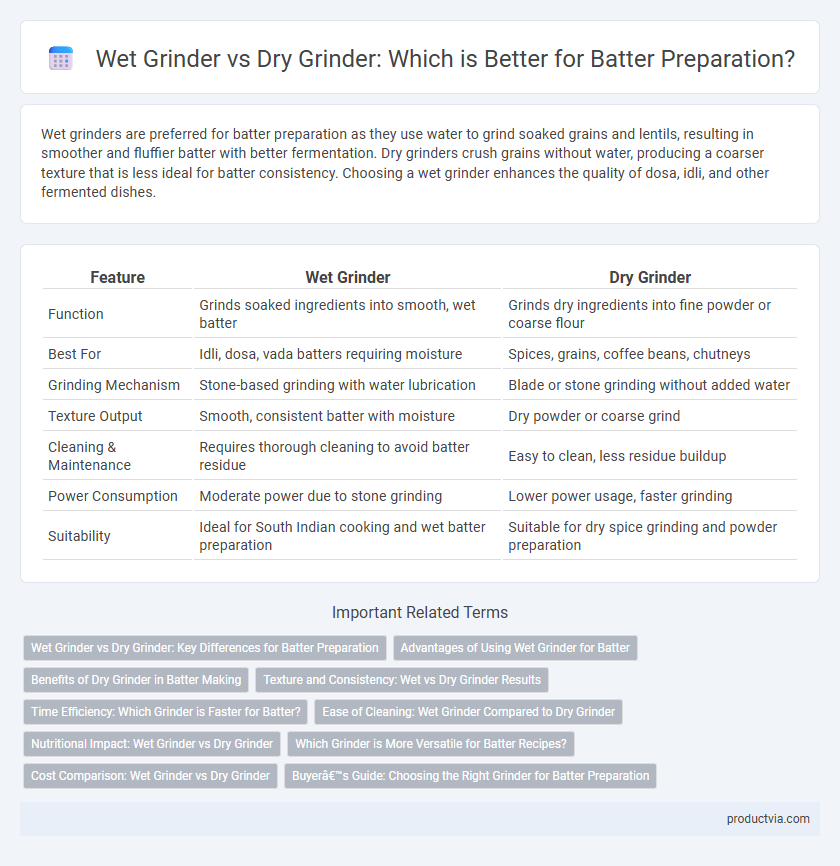Wet grinders are preferred for batter preparation as they use water to grind soaked grains and lentils, resulting in smoother and fluffier batter with better fermentation. Dry grinders crush grains without water, producing a coarser texture that is less ideal for batter consistency. Choosing a wet grinder enhances the quality of dosa, idli, and other fermented dishes.
Table of Comparison
| Feature | Wet Grinder | Dry Grinder |
|---|---|---|
| Function | Grinds soaked ingredients into smooth, wet batter | Grinds dry ingredients into fine powder or coarse flour |
| Best For | Idli, dosa, vada batters requiring moisture | Spices, grains, coffee beans, chutneys |
| Grinding Mechanism | Stone-based grinding with water lubrication | Blade or stone grinding without added water |
| Texture Output | Smooth, consistent batter with moisture | Dry powder or coarse grind |
| Cleaning & Maintenance | Requires thorough cleaning to avoid batter residue | Easy to clean, less residue buildup |
| Power Consumption | Moderate power due to stone grinding | Lower power usage, faster grinding |
| Suitability | Ideal for South Indian cooking and wet batter preparation | Suitable for dry spice grinding and powder preparation |
Wet Grinder vs Dry Grinder: Key Differences for Batter Preparation
Wet grinders use water and abrasive stones to grind soaked grains and lentils into smooth, consistent batter ideal for idlis and dosas, preserving natural flavor and nutrients. Dry grinders rely on rapid grinding with metal blades or burrs, producing coarse flour rather than smooth batter, making them less suitable for traditional South Indian recipes. Wet grinders generate less heat during grinding, preventing fermentation issues and resulting in better texture and taste for batter preparation.
Advantages of Using Wet Grinder for Batter
Wet grinders excel in preserving the natural moisture and texture of batter, resulting in smoother and more aerated mixes essential for dishes like dosa and idli. Their stone grinding mechanism generates less heat compared to dry grinders, maintaining the nutrients and enhancing fermentation efficiency. Wet grinders also reduce batter oxidation, improving taste and shelf life, making them the preferred choice for batter preparation.
Benefits of Dry Grinder in Batter Making
Dry grinders produce finer, more uniform flour particles that enhance batter texture and consistency. They eliminate moisture from ingredients, reducing spoilage and extending shelf life of the batter. The dry grinding process also helps retain essential nutrients and natural flavor compounds, resulting in healthier and tastier batter.
Texture and Consistency: Wet vs Dry Grinder Results
Wet grinders produce batter with a smoother texture and more consistent moisture content, essential for dosa and idli preparation. Dry grinders tend to yield a coarser grind, resulting in batter with uneven consistency that may affect fermentation and final dish quality. The even particle size from wet grinding enhances batter aeration, leading to softer, fluffier end products.
Time Efficiency: Which Grinder is Faster for Batter?
Wet grinders are faster for batter preparation due to their ability to grind soaked grains and lentils smoothly in less time, typically completing the process within 20-30 minutes. Dry grinders take longer as they require grinding dry grains followed by soaking and further processing, extending the overall preparation time. Time efficiency is significantly higher with wet grinders, making them ideal for quick batter preparation.
Ease of Cleaning: Wet Grinder Compared to Dry Grinder
Wet grinders typically offer easier cleaning due to their use of water, which helps to dissolve and wash away batter residue more effectively than dry grinders. The detachable parts of wet grinders are often designed for quick rinsing and minimal maintenance, reducing residual buildup. In contrast, dry grinders can retain dry particles within blades and chambers, making thorough cleaning more labor-intensive and time-consuming.
Nutritional Impact: Wet Grinder vs Dry Grinder
Wet grinders retain the natural moisture and nutrients of ingredients, preserving enzymes, vitamins, and minerals crucial for health. Dry grinders generate heat that may degrade sensitive nutrients and reduce the batter's nutritional profile. Choosing a wet grinder often results in batter with better texture and higher nutritional value, ideal for healthy cooking.
Which Grinder is More Versatile for Batter Recipes?
Wet grinders excel in grinding soaked grains and lentils to create smooth, consistent batter essential for traditional South Indian dishes like dosa and idli, making them highly versatile for wet batter recipes. Dry grinders are better suited for grinding dry spices and pulses but cannot achieve the same batter texture as wet grinders, limiting their use in batter preparation. For versatility in batter recipes requiring finely ground, moisture-rich consistency, wet grinders are the preferred tool.
Cost Comparison: Wet Grinder vs Dry Grinder
Wet grinders typically cost between $80 and $300, offering efficient batter grinding with consistent texture, making them suitable for frequent use. Dry grinders range from $40 to $150 and are generally more affordable but may produce coarser batter with less moisture retention. Investing in a wet grinder ensures better battter quality and durability despite the higher initial price.
Buyer’s Guide: Choosing the Right Grinder for Batter Preparation
Wet grinders use water to grind soaked grains and lentils, producing smooth, fluffy batter ideal for dosas and idlis. Dry grinders pulverize dry ingredients into fine powders but cannot achieve the batter consistency wet grinders provide. For batter preparation, choose a wet grinder with stainless steel drum and multiple grinding stones for efficient, consistent texture and moisture retention.
Wet grinder vs Dry grinder for batter Infographic

 productvia.com
productvia.com